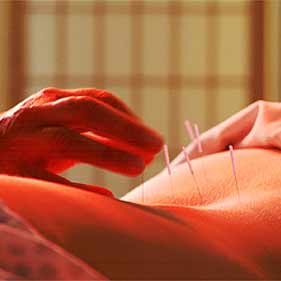Acupuncture Works Well For Low-Back Pain

Researchers have reported that acupuncture is an effectual option for low-back pain, as compared to conventional therapy. In the Sept. 24 issue of Archives of Internal Medicine, Heinz G. Endres, M.D. of Ruhr-University Bochum and his co-workers has reported that more patients acted in response to acupuncture as compared to conventional therapy.
But, sham acupuncture worked just as well as verum, or true, acupuncture, they reported.
The study authors reasoned out, “Acupuncture constitutes a strong alternative to multimodal conventional therapy. Acupuncture gives physicians a promising and effective treatment option for chronic low-back pain, with few adverse effects or contraindications.”
As for the equally favorable outcomes with false or genuine acupuncture, the researchers said, “The superiority of both forms of acupuncture suggests a common underlying mechanism that may act on pain generation, transmission of pain signals, or processing of pain signals by the central nervous system and that is stronger than the action mechanism of conventional therapy.”
Used to deal many medical situations, acupuncture has a controversial role in managing low-back pain, even though a latest Cochrane survey resolved that it might be helpful as an addition to other treatments.
Dr. Endres and fellow workers reported findings from what they think to be the first randomized, manipulated assessment of verum against sham acupuncture for low-back pain treatment. The German Acupuncture tests involved practitioners in 340 outpatient practices and comprised 1,162 patients who have had low-back pain from last 8-years.
They were treated with either verum or sham acupuncture or conventional therapy, which comprised of a mixture of drugs, physiotherapy, and work out. Verum acupuncture comprised of 10 30-minute sittings of treatment in line with rules of traditional Chinese medicine. Patients ascribed to sham acupuncture received superficial needling at non-acupuncture points.
The key result was six-month response rate, with reaction outlined as at least 33% betterment on three pain-related items on the Von Korff Chronic Pain Grade Scale or 12% perfection on the back-specific Hanover Functional Ability Questionnaire.
In the last part of the study, 47.6% of patients involved in the verum acupuncture group had reacted, as had 44.2% in the sham acupuncture set, and 27.4% in the group, which got conventional therapy. Both acupuncture groups had shown considerably advanced response rates as compared with conventional therapy.
The authors stated that the inadequacy of conventional treatment to both acupuncture groups brings up doubts regarding qualitative as well as quantitative faces of conventional therapy. Despite that, outcomes with conventional therapy outperformed those detected in a earlier German-based study of routine care for low-back pain.
They also commented, “The effectiveness of sham acupuncture and the principle of nihil nocere suggest that a discussion is called for about the necessary depth of insertion of acupuncture needles.”
Rex Marco, M.D., an orthopedic surgeon at the University of Texas Health Science Center in Houston commented that the finding that both sham and true acupuncture alleviated back pain is confusing. He conjectured that the sham needling could have activated endorphin release or other possibly therapeutic outcomess. The sham processes also could have had an unexpectedly large medication consequence.
On the other hand, he believed, the pain-relieving advantages of sham acupuncture might have been exciting or emotional in nature.
Dr. Marco said, “It’s possible that the physical contact during the sham procedures had a relaxing or soothing effect that helped relieve the pain. Maybe the contact and interaction with the acupuncturist was beneficial. It's really impossible to know why the sham procedures had a therapeutic effect. For that matter, it's entirely possible that the sham and true procedures worked through similar or the same underlying mechanisms.”